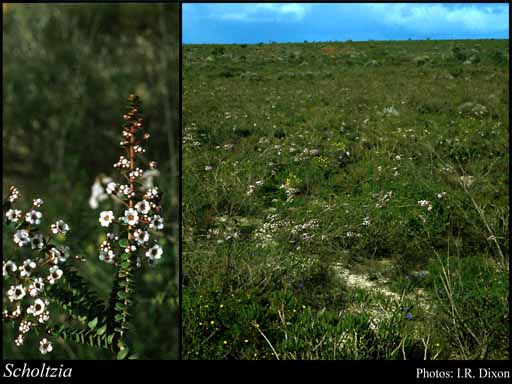- Reference
- Linnaea 17:241 (1843)
- Name Status
- Current

Scientific Description
Common name. Scholtzias. Family Myrtaceae.
Habit and leaf form. Shrubs; evergreen; bearing essential oils. Plants with neither basal nor terminal concentrations of leaves; to 0.1–3 m high. Leptocaul. Helophytic to xerophytic. Leaves minute to small; opposite (or in opposite bundles); decussate; ‘herbaceous’, or leathery; petiolate to sessile; gland-dotted; aromatic; edgewise to the stem, or with ‘normal’ orientation; simple; epulvinate. Leaf blades dorsiventral, or isobilateral, or centric; entire; flat, or solid; terete, or semi-terete; linear, or lanceolate, or oblong, or ovate; linear, or ovate, or obovate, or elliptic, or orbicular; pinnately veined, or parallel-veined, or one-veined; cross-venulate, or without cross-venules. Mature leaf blades adaxially glabrous; abaxially glabrous. Leaves without stipules; without a persistent basal meristem. Leaf anatomy. Hairs absent. Stem anatomy. Secondary thickening developing from a conventional cambial ring.
Reproductive type, pollination. Fertile flowers hermaphrodite. Unisexual flowers absent. Plants hermaphrodite. Entomophilous, or ornithophilous. Pollination mechanism conspicuously specialized, or unspecialized.
Inflorescence and flower features. Flowers solitary, or aggregated in ‘inflorescences’; axillary; 1–5 per axil; in heads, or in umbels. Inflorescences simple, or compound. The terminal inflorescence unit cymose. Inflorescences intercalary, or terminal, or axillary; of clusters, sometimes forming a leafy umbel with 1-several flowers per peduncle. Flowers pedicellate to sessile; bracteate. Bracts deciduous. Flowers (bi) bracteolate. Bracteoles persistent, or deciduous. Flowers small; regular; 5 merous; cyclic. Free hypanthium present (petals ‘inserted on the calyx’); campanulate, or turbinate. Perianth with distinct calyx and corolla; 10; 2 -whorled; isomerous. Calyx present; 5; 1 -whorled; polysepalous, or gamosepalous (depending on interpretation). Calyx segments entire. Calyx spreading; imbricate, or valvate; exceeded by the corolla; regular; persistent, or not persistent. Corolla present; 5; 1 -whorled; polypetalous; imbricate; regular; white, or pink. Petals obovate, or orbicular. Androecial members definite in number, or indefinite in number. Androecium 5–25. Androecial members branched, or unbranched. Androecial sequence determinable, or not determinable. Androecial members if ‘many’, maturing centripetally; free of the perianth; all equal; free of one another; 1 -whorled. Stamens 5–25; attached on the rim of the hypanthium; remaining included; isomerous with the perianth, or diplostemonous, or polystemonous; oppositisepalous, or alternisepalous and oppositisepalous; both opposite and alternating with the corolla members, or all alternating with the corolla members; erect in bud, or inflexed in bud. Filaments geniculate (apparently, in S. eatoniana and S. umbellifera), or not geniculate; filiform (or slightly compressed). Anthers dorsifixed; versatile; dehiscing via pores, or dehiscing via short slits (pore or slit terminal); introrse; cells parallel but often partially separated by a cleft; tetrasporangiate; appendaged (usually with a thickened connective and terminal globular gland), or unappendaged. Gynoecium 2–3 carpelled. The pistil 2(–3) celled. Gynoecium syncarpous; eu-syncarpous; inferior. Ovary plurilocular; 2(–3) locular. Epigynous disk present. Gynoecium stylate. Styles 1; simple; from a depression at the top of the ovary; apical; not becoming exserted; hairless. Stigmas 1; truncate, or capitate. Placentation axile. Ovules (1–)2(–3) per locule; ascending; superposed (if more than 1); non-arillate; anatropous.
Fruit and seed features. Fruit non-fleshy; dehiscent, or indehiscent (sometimes); a capsule, or capsular-indehiscent. Capsules septicidal, or loculicidal, or denticidal, or circumscissile. Fruit 2 celled; 2–4 seeded. Seeds 1–2 per locule. Seeds non-endospermic. Cotyledons 2.
Geography, cytology, number of species. Native of Australia. Endemic to Australia. Australian states and territories: Western Australia. Eremaean Botanical Province and South-West Botanical Province.
Etymology. After Heinrich Scholtz (1812–59), physician of Bratislava who studied the flora and fauna of Silesia.
Keys
A Key to Western Australian Species in the Chamelaucieae Tribe of Myrtaceae
B.L. Rye, M.D. Barrett, T.D. Macfarlane, N.S. Lander, M.E. Trudgen, N.G. Marchant, K.R. Thiele
Taxonomic Literature
- Marchant, N. G.; Wheeler, J. R.; Rye, B. L.; Bennett, E. M.; Lander, N. S.; Macfarlane, T. D.; Western Australian Herbarium 1987. Flora of the Perth region. Part one. Western Australian Herbarium.. [Perth]..
- Blackall, William E.; Grieve, Brian J. 1980. How to know Western Australian wildflowers : a key to the flora of the extratropical regions of Western Australia. Part IIIA. University of W.A. Press.. [Perth]..